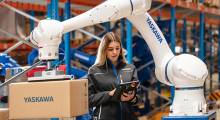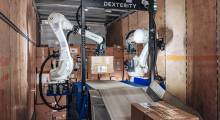Osvald Jensen A/S is a Danish-based, family-owned manufacturing business with in-house production of worm gears marketed under its own brand. The company set about automating various manufacturing tasks to increase productivity, eliminate repetitive and strenuous duties, and lower the risk of errors. Since 2015, the company has used collaborative robots (cobots) to load and unload computer numeric control (CNC) machines. However, after upgrading their cobots with dual grippers, the company cut cycle time nearly in half.
Previously, the single-gripper robots would load a part, wait for the process to finish, unload the part, and pick up a fresh one. The entire cycle took 27 seconds. Although the process was much faster than humans alone, the Osvald Jensen team knew it could do better.
The new dual grippers (OnRobot) handle two objects at the same time. Mounted on cobot arms without any external wires, the new grippers have infinite rotation of the last joint, which adds flexibility and productivity. The grippers can be easily programmed directly from the same interface as the robot, and the gripper can be modified without previous programming experience, making them ideal for collaborative robot users.
“We realized that with another cost-effective investment, we could improve our productivity even further,” says Christian Viereck, head of production at Osvald Jensen.
The dual gripper now finishes the task in 15 seconds, an improvement of 12 seconds on every cycle. The company is able to complete each task faster and can continue to perform the task without an operator present, even overnight. The only thing the operators have to do is load the magazines with raw material. Viereck says workers have been relieved from tedious and monotonous work and are now free to spend time on more value-added tasks. In addition, the more stable and consistent operation produces parts that are much closer to ideal tolerances due to reduced variation in temperature, humidity and other factors.
“We have invested a lot in our CNC machines, and with collaborative robots we can automate them in a very cost-effective way,” Viereck says. “We had a return on investment in less than three months.”
About the Author
Follow Robotics 24/7 on Linkedin
About the Author
Follow Robotics 24/7 on Linkedin
Article topics
Email Sign Up
















